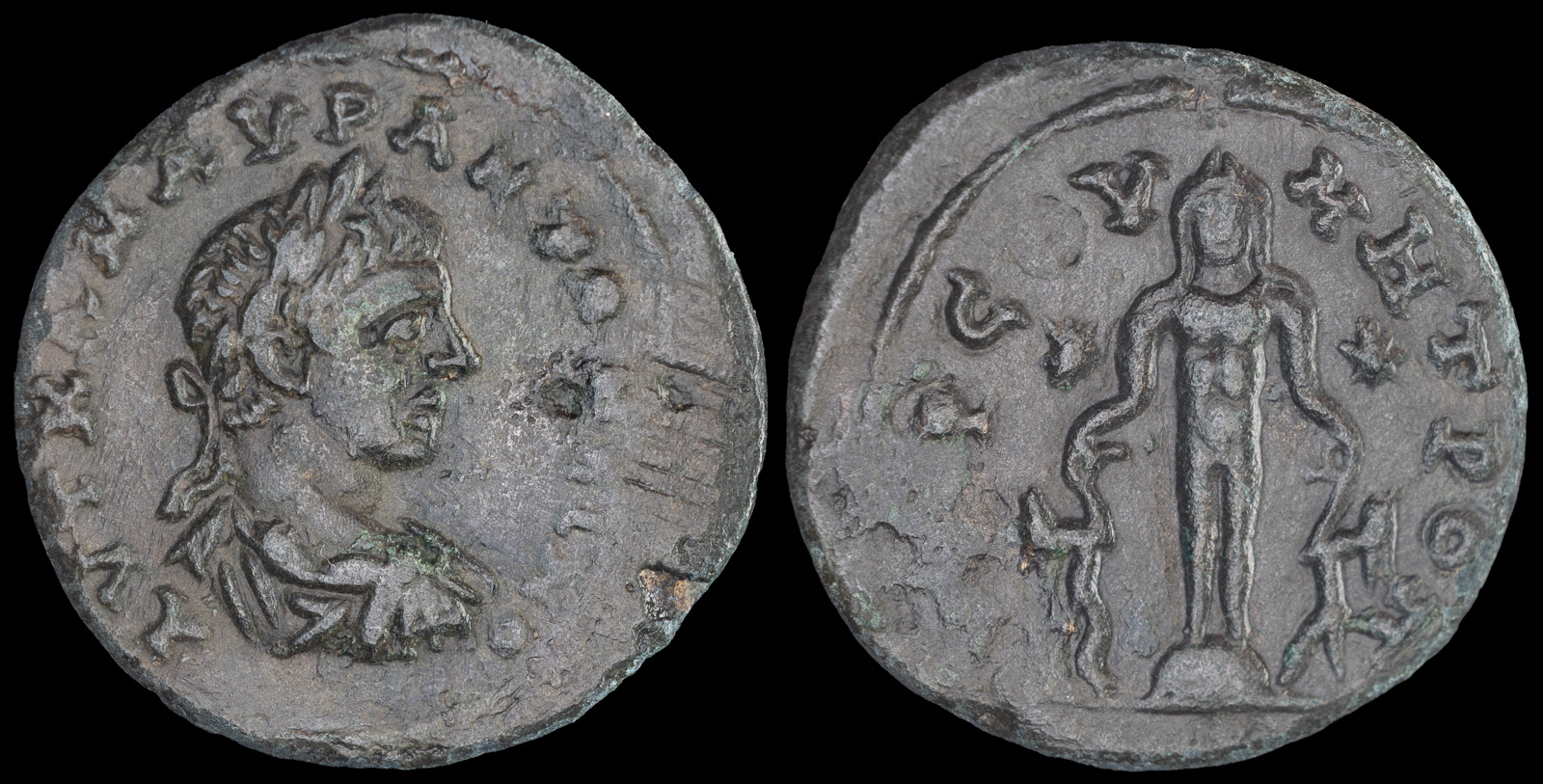
Kilikia, Tarsos
Elagabalus. 218-222 CE
AE Diassarion 7.16g, 25mm
Obv.: AVT KA M AVP ANTΩNINOC, laureate, draped and cuirassed bust right, seen from behind; below, star.
Rev.: TAPCOY MHTPO, Apollo Lykeios standing facing on omphalos, holding a wolf by the forepaw in each hand; to left and right, stars.
SNG Levante 1082; SNG Paris 1559
A long time ago there lived a king named Belos with two sons, Aegyptos and Danaus. Aegyptos had only Y chromosomes, while Danaus only had X. Both got very busy and soon Aegyptos had accumulated 50 sons and Danaus 50 daughters. When Aegyptos proposed 50 weddings between them, Danaus was equally concerned about the potential for birth deformities and the probability that Aegyptos meant to annihilate his line, so he sailed away.
First, they sailed to Rhodes, where three daughters died and thus provided a convenient name to three cities. Then, they sailed to Argos, where Danaus promptly declared himself king. There were only two slight problems.
First, Argos already had a king. Second, the Argives had no idea who this guy Danaus was. However, before they refused him outright, one of the villagers noted that a guy who can sail around the Aegean with fifty teenage daughters and not go completely insane must be given some consideration, and thus they decided to table the matter for the night.
That evening, a wolf wandered down the hill and killed the largest bull. This, the Argives took as a sign that Danaus meant business, so they persuaded the current king to resign and gave the job to Danaus, who promptly tipped the wolf fifty bucks.
Danaus, for his part, felt that the only possible solution for the wolf’s behavior was that it was really Apollo in disguise, so he erected a temple to Apollo Lykeios in Argos. The statue of Apollo with two wolves is depicted on this coin.
Of course, the astute among you may notice that this coin is from Tarsos, not Argos. The reason for this is another story.
Some time ago there lived a woman named Io, who was a priestess of Hera. Unfortunately for her, she was drop-dead (really dead, since she was pals with Hera) gorgeous, and none other than Zeus took a liking to her. Hera of course, was no fool, and when she caught the two in the act on their new memory-foam mattress of all places, Zeus immediately turned Io into a cow and claimed…well I’m not sure how he explained a cow on the bed, but he proclaimed there was no Io.
Hera went along with the story, and took the ex-Io-now-cow back home with her and chained her to a tree. Zeus, not willing to give up the game, hired Hermes to release her, but Hera had thought of that one too. She had a gadfly pester Io, who went mad from the torture and ran across the world.
Now, one of the myths on the search for her was that Triptolemos decided to lend chase and a bunch of Argives asked if they could tag along. When they reached Tarsos, things must have reached a boiling point. The Argives had been playing the same CD of Golden Oldies the entire voyage, and Triptolemos was sick of it. Therefore, the Argives jumped ship, walked over to Tarsos, and founded a city.
This story neglects a number of important details, such as why Triptolemos was involved in this whole thing, why the Argives needed to go too, and the fact that a city had already existed at Tarsos for thousands of years. Clearly the story is a major case of “mythologers’ license.”
But, to cut things short, Tarsos claimed a link with Argos and thus brought the Apollo Lykeios story too.
I should probably now mention that even the definition of “Lykeios” was hotly debated in ancient times. Some felt it actually meant “from Lycia”, since Apollo favored the Anatolian Trojans in the Trojan War. Others stated that it mean “light” from the Greek word “Lyke” and the fact that Apollo was the “Lord of Light.” Ancient literature suggests that the meaning depended on context.
Coming back to numismatics, what would possess the Tarsians of minting such an image? Well, temples were a big thing back then. If you could promise some oracle or important religious artifact, that meant big drachms for the city. Thus, coinage was a way to advertise this fact. Come one, come all to the fabulous Temple of Apollo Lykeios, situated in the Metrpolis that is Tarsus!
Finally, it should be noted that the design of the sculpture is very Anatolian. This is not something you would expect in the Peloponnese, and thus it’s a further example of the meshing of cultures.